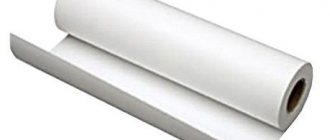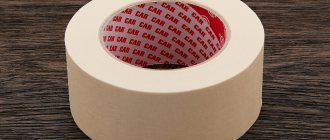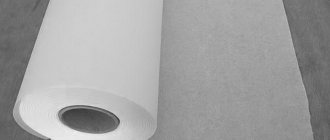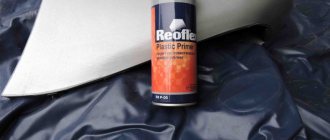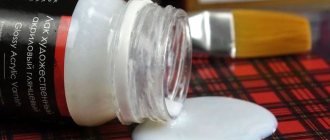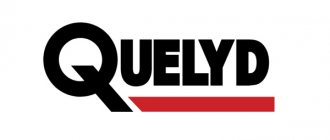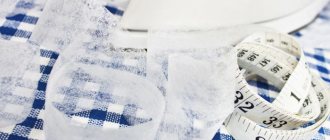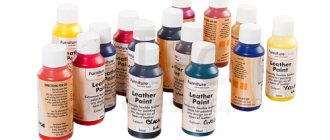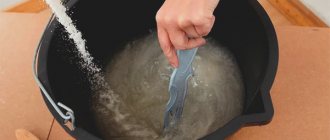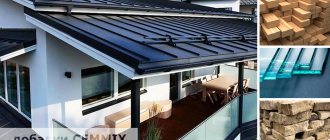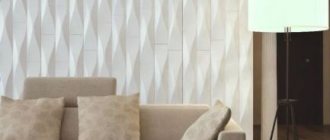Painting non-woven fabric is distinguished by its smooth texture; the material is non-woven, and has many similar parameters to fiberglass material. It differs from fiberglass in thickness, it is thinner. This thickness is achieved by using polymer binders for the production of cellulose and textile fibers. The features of the material will be discussed in detail below.
Features and purpose of painting non-woven fabric
Painting non-woven fabric is distinguished by its smooth texture; the material is non-woven, and has many similar parameters to fiberglass material. It differs from fiberglass in thickness, it is thinner. This thickness is achieved by using polymer binders for the production of cellulose and textile fibers. The features of the material will be discussed in detail below.
Reviews
I had no idea what non-woven fabric was until I was faced with the problem of repairing my favorite pants. This material was recommended to me at a fabric store. It’s quite easy to use; I didn’t need any special skills to work with it.
A good alternative to old lining fabric options. Really very suitable as an understudy for delicate fabrics. I often use it for home repairs of clothes.
Non-woven fabric is a universal material used in a variety of fields. This is a new trend in the big world of clothing production.
Purpose of painting non-woven fabric
Non-woven canvas is used as a reinforcing layer; the surface can be painted on top of it, or other decorative materials can be installed. It is similar to painter’s fiberglass, which in everyday life is called “cobweb”, and helps to contain cracks on the surface.
The application is associated with the desire to obtain a durable and highly resistant finish. Can be used in apartments, private houses, office buildings and other structures. Separately, they note the ease of its installation, after which it will be possible to update the finish on top of the canvas several times.
Tools and materials for work
Stock up on the following tools:
- construction knife or scissors for cutting cloth;
- long ruler, pencil and cutting square;
- ladder;
- a roller with a long handle or a brush for applying glue to the ceiling;
- container for mixing glue;
- rubber roller for leveling wallpaper;
- plastic spatula;
- a rag for removing glue from the surface of the wallpaper;
- paint tray;
- rollers and brushes for paint.
Also buy high-quality non-woven wallpaper, glue for heavy coverings, and ceiling skirting boards.
Advantage of the material (declared by the manufacturers)
Non-woven fabric for painting is environmentally friendly and does not harm human health, so it can be used in any room. Security explained:
Another plus is the ability to cover surface imperfections, so this is a good option if you intend to paint the walls, glue wallpaper or install other finishing materials.
It helps to create unusual design ideas on the surface using plaster and putty mixtures. In addition, it has tensile strength. It is for this reason that it is similar to reinforcing products. Able to hide and also retain cracks, it is also noted that non-woven fabric:
Manufacturers claim that the material can provide a strong connection with many types of substrates:
It is impossible to say with certainty that such a solution will help to completely avoid problems with these surfaces, because other difficulties may arise with the old finish and poorly adhering base. In practice, it has been found that it is better to choose fiberglass for damaged walls; in the end it will cost less due to a better result.
To successfully use this building material, it is necessary to bring the base to the following parameters:
The canvases are distinguished by their surface stability, so applying a new coating is allowed several times. It will be easy to remove the outdated finishing material from it, but the non-woven canvas itself will not be damaged during this process.
The same can be done if the base was painted; you can repaint the surface many times. If you need to remove the canvas itself for painting, then dismantling it is not difficult. In addition, they note the properties: light resistance, sound insulation, lasts up to 25 years. The downside is that it attracts dust on the embossed surface, and the embossed texture is weak to mechanical damage.
Pasting non-woven wallpaper - affordable and unique
The most popular type of decorative covering is, of course, wallpaper.
Although the construction industry offers many decors, most often people use them, especially since since the advent of non-woven wallpaper, repairs have become much easier and more convenient, especially for those who prefer to do it themselves.
When choosing between non-woven or paper-based wallpaper, many choose the first option, since this type of wall and ceiling covering has a number of advantages.
Firstly, they have a dense structure, so that minor imperfections in the surface to be coated will not cause problems with gluing.
Secondly, there is no shrinkage; Besides the fact that the work of sticking them is not difficult, you can do it yourself.
Also, the base can be different: concrete, wooden, plasterboard or plastered walls; Yes, and you can glue it to both walls and ceilings. There are types that can be painted any color.
The only big negative is the airtightness.
So, if you decide to hang non-woven wallpaper with your own hands, follow the instructions.
Simple Arithmetic
The decision has been made, you can go to the store. In order not to run around, worry or look for the same roll of wallpaper in case of shortage, you need to take a responsible approach to the calculation process.
It is best to measure the height, length, width of the room and draw a plan, as well as find out the length of the wallpaper roll. Based on the data, you need to divide the length of the roll by the height of the wall, this will be the number of whole strips in 1 roll.
The length of the room, excluding windows and doors, is divided by the width of the roll; this will be the number of strips needed to cover the room. This total quantity is divided by the number of strips in the roll, and the required number of rolls for repair is obtained.
Preparatory stage
Before pasting, it is necessary to clean the base from dust, remnants of the old coating, and seal the drywall joints.
It is best to putty the base and then prime it to get rid of excess moisture.
It is important to remember that interlining is transparent, which means you need to exclude bright and dark colors of the wall being pasted over, choosing a putty that is uniform in tone.
Don't forget to unscrew the sockets and switch, and insulate the wires to avoid a short circuit if glue gets in there.
In order for the room to look cozy, and the beauty of the room with non-woven wallpaper not to be distorted, you need to correctly mark the walls.
It is advisable to start gluing from the corner, so using a level and a pencil you need to draw a vertical line to the height of the growth. From this point the gluing of non-woven wallpaper with your own hands will begin.
DIY creative work
It is best to lay the wallpaper on the floor, having previously laid something down, and carefully cut it into strips (it is worth remembering that for wallpaper without a pattern, you need to add about 9 cm of excess canvas).
How to choose painting non-woven fabric
If the choice is made in favor of this material, then you should pay attention to the selection of high-quality rolls. As mentioned earlier, painting non-woven fabric is environmentally friendly, so it is worth asking the store for certificates of quality and compliance.
You should check its texture, it feels perfectly smooth to the touch, without any flaws, the edges are also smooth. It should not be possible to stretch it, the texture is elastic. They check the composition, there should be no chemical elements present, and there should not be any other unclear designations. The consultant must professionally answer questions about the material, otherwise you should not trust him.
Density
In addition to the important points described above that you should know when choosing non-woven fabric, you should clarify the level of its density. The maximum density reaches 160 grams per square meter, the minimum density is 110 grams. The color is white.
The maximum density reaches 160 grams per square meter, the minimum density is 110 grams.
Features and advantages of non-woven canvas gluing technology
The process of installing non-woven fabric for painting is easy; you start by applying wallpaper glue to the base itself, then sheets of reinforcing material cut to the size of the surface are applied to the adhesive layer. On the surface, smoothing and distribution of the product occurs quickly and without problems. Therefore, a beginner can easily carry out the entire process without turning to a professional for services.
This technology for installing non-woven fabric helps reduce the consumption of adhesive solution. But first, the surface should be properly prepared so that it is free from flaws and smooth. The mixture is selected based on the condition of the surface.
The adhesive solution is prepared thick, the wall is carefully coated with it, the interlining itself should be mounted using a plumb line so as not to be mistaken in its evenness. The strips are glued end to end and pressed to secure them well.
If the strips are too long, then carefully cut the excess part with a sharp knife. When the drying period specified by the material manufacturer has passed for the adhesive solution, they proceed to further finishing work.
How to hang non-woven wallpaper: a step-by-step description of the process with photos and videos
The question of how to glue non-woven wallpaper worries many who have chosen this practical and high-quality material. Its main feature is its thickened structure, thanks to which it is possible to successfully hide minor wall defects. The non-woven coating is wear-resistant, moisture-resistant, light-resistant, does not require maintenance and has an original relief surface. If you want to change the interior design, this coating can be repeatedly painted with dispersion or acrylic dyes. The process of pasting walls is simple and does not take much time; you just need to familiarize yourself with some secrets of working with wallpaper.
Sequence of work
Gluing non-woven wallpaper with your own hands has some features. To know how to properly glue non-woven wallpaper, we recommend that you familiarize yourself with the following recommendations to avoid mistakes during work:
- before starting work, be sure to read the manufacturer’s instructions included with the rolls and the packaging of the adhesive mixture;
- Before gluing the canvas, prepare the surface of the walls. You should start gluing only after the primer has completely dried;
- pay close attention to gluing the first blank - the quality of the entire work directly depends on this;
- The pasted sheet should be leveled using a rubber spatula (if the surface of the wallpaper is smooth) or a wallpaper roller (if the canvas has a textured surface);
- Each subsequent sheet must be glued without overlap - strictly end-to-end. If this is impossible to do, for example, when gluing the canvas in the corners, use the double-cut method: placing two sheets on top of each other by 5-6 cm, you need to make an even cut with a stationery knife at the point of their connection, then carefully removing the excess. This way the angles will be perfect;
- the joints of the sheets (especially the corners) should be carefully ironed with a spatula or roller, removing excess glue to the side free from the wallpaper;
- To remove excess glue, use a damp sponge, carefully wipe the seams in the corners, do not worry about the condition of the canvas - moisture will not damage it.
Stages of gluing non-woven wallpaper on a wall
Preparing and marking the walls is an important point that should be given special attention before gluing non-woven wallpaper. You should also cut the sheets correctly and choose the appropriate composition for gluing them.
Preparatory work
Non-woven wallpaper can be used to cover any surface. If you plan to paint wallpaper in the future, you should take care in advance that the walls have a uniform color, not very different from the color of the chosen paint, since non-woven material is a thin material and the color of the base may be noticeable in the future.
The walls should first be cleaned (remove the old coating) and any existing defects should be eliminated. Then it is necessary to carefully treat the surface with a primer; it is better to apply a deep penetration primer - this will increase the adhesive ability of the glue. After the primer has completely dried, you can proceed to marking the walls. It is recommended to start pasting meter-long wallpaper from the corner - use a level to apply vertical lines on the walls, at a distance of 1 m from each other, this will avoid unevenness and defects in the work.
The next step is preparing the canvas. If you choose a plain material, there will be no problems with cutting. If you plan to glue a canvas with a pattern, make sure that it matches; to do this, you will have to periodically move the next sheet down or up. When cutting, be sure to leave a height margin of 5-7 cm - an allowance for the ceiling; cut off the excess part with a stationery knife after it has completely dried.
When cutting wallpaper sheets, do not forget to leave a small margin
Sheets must be cut on a clean surface with the roll face down. Having measured the required length of the workpiece (taking into account the margin), you should make a notch, bend the sheet evenly (make sure that the edges of the bottom part of the sheet coincide with the edges of the bent part) and cut it along the fold line. The next piece must be rolled out in the same way and before cutting, check the fit of the pattern. Further work is performed in a similar sequence.
After preparing the walls and canvas, you can begin to solve the next question - how to properly glue non-woven wallpaper? An important point is the choice of suitable glue; the quality of the final work depends on this.
Choosing glue
To paste walls with non-woven wallpaper, you should use a certain adhesive composition, which can be purchased at a specialized store selling construction and finishing materials.
Before preparing the adhesive mixture, carefully read the instructions for the gluing process that come with the wallpaper - some manufacturers recommend applying glue not only to the walls, but also to the canvas itself.
- does not contain toxic substances and is absolutely safe for human health;
- has excellent adhesive properties, allowing the mixture to be applied to any surface;
- easy to use;
- does not leave stains;
- has a long shelf life in a closed container (up to 10 days).
The process of making the adhesive mixture itself is not complicated - the powder should be diluted in the amount of water specified in the instructions, constantly stirring until the mass thickens.
How to properly glue meter-long non-woven wallpaper
Gluing non-woven wallpaper with your own hands is not a labor-intensive process, but if you choose a meter-long canvas, you should take into account several nuances. Many people prefer meter rolls, since this greatly simplifies the gluing process, there are fewer joints and less material consumption.
What is the difference between painting non-woven fabric and fiberglass?
To understand exactly which of the similar materials is better to choose – fiberglass or non-woven fabric, you should study their differences and features of use. The first type of reinforcing product does an excellent job of covering surface imperfections, containing and preventing the appearance of cracks. Suitable for use as a base for painting surfaces or gluing wallpaper. It will give strength to the wall or ceiling on which it will be glued.
It is most often used in buildings where durability and wear resistance are not required, such as low-cost office spaces. The non-woven look is a more effective option for finishing walls in a residential building or apartment, where the owners often want to make repairs without spending a lot of time on it.
Also, painting non-woven fabric is distinguished by its environmental composition, good vapor permeability, and fire safety. It is easier to carry out repair work with it; its resistance to moisture allows you not to be afraid of changes in structure and deformation over time.
Material selection
Non-woven wallpaper is a material that requires special attention when choosing. After all, not only aesthetics, but also practicality and durability of the finish depend on its quality.
Several criteria can be identified, based on which it is advisable to choose a high-quality construction non-woven fabric:
- Structure. Non-woven lining is known for its uniform and silky texture. Therefore, if any foreign inclusions, inhomogeneities or other visually noticeable defects are detected, it is better to refuse the purchase. Flaws on the surface indicate unfair production or a violation of the technological process.
- Edges of the substrate. Good manufacturers pay great attention to the quality of edge processing. They must be perfectly smooth and solid. Tears or loose edges can not only deteriorate the appearance of the decorative surface, but also lead to a decrease in the overall service life.
- Elasticity. Painting non-woven fabric should be resilient, despite its elasticity. The ability of the lining to withstand mechanical stress and return to its shape depends on its elasticity. When purchasing, you should pay attention to the presence of dents or bends on the roll. The highest grade substrate is not characterized by their presence.
- Strength. You can determine it by pulling a section of non-woven fabric in different directions. If it is even slightly stretched, this indicates insufficient strength. High-quality material is not subject to stretching.
- Compound. The non-woven base is subject to mandatory certification. Therefore, when purchasing a lining, you must ask the seller for quality certificates for the products. There should not be any chemical impurities in the composition.
To be sure of quality, it is better to give preference to products from already established brands.
Non-woven backing for wallpaper is a unique durable material that can restore its shape. Resistance to various influences makes it one of the most practical types of substrates - strong, reliable and durable.
Instructions for gluing painting non-woven fabric
The main advantage of canvas for painting or wallpaper is the ease of installation; it is simply glued to the wall. For this purpose, it uses wallpaper glue; there are no special requirements for wallpaper glue, the material is not heavy. The ceiling or wall should be coated; the ability to work with the ceiling is also a plus of the product.
Cutting strips is easy, the material can be measured very accurately, and on the surface it quickly straightens, this is due to its elasticity property, which you need to be sure of when purchasing in order to choose a quality product.
It is recommended to use it on a leveled surface; you do not need to remove the well-adhering old coating. The glued interlining will serve for many years; you can glue it to it or paint the surface with new wallpaper/paint if you want to update the interior. If the decision is made to carry out a major overhaul, it will be easy to remove the stripes; removal takes place in a dry state.
Further painting can be carried out using the standard method using a roller or spray gun. But, if dark colors are applied, then it is better to repaint them no more than three times.
Painting non-woven fabric is a high-quality product that will help make the wall more durable, and will reduce time and expenses for updating surface finishes, without harming human health. You can glue it to the wall or ceiling with your own hands, without resorting to the services of specialists, which will significantly save the family budget. But in order to get all the declared characteristics, you should choose the brand with special attention.
Features of the work
To achieve a positive result, just purchasing good material is not enough; it is important to carry out all the work in accordance with the technology. In fact, everything is quite simple, but you should still remember the basic rules.
Preparatory stage
At this stage, you should first prepare all the necessary materials:
- Sufficient amount of non-woven covering with a small margin just in case.
- Glue for non-woven coverings, and remember that its consumption will be slightly higher than when working with wallpaper coverings.
The price of good glue, as in the photo, is quite high, but in no case is it worth saving on it
- If the surface to be finished has uneven surfaces, they should be repaired using putty; it is best to choose an acrylic composition.
- To level the material when gluing sheets with your own hands, it is better to use a special spatula.
Using this device it is very convenient to smooth the surface and expel air from under the material
Next, the surface should be prepared; within this stage, the following work is carried out:
- All debris and dust must be removed. After this, the wall or ceiling to be finished is carefully inspected for damage and flaws.
- If there are uneven surfaces, they must be repaired using putty. After it dries, it is necessary to sand it using a special block with replaceable sanding sheets.
Important! If you are going to cover a wall finished with plasterboard, then you need to putty all the seams and fastening points. In this case, it is recommended to use fiberglass mesh on the seams for additional protection against cracking.
Leveling the plasterboard surface is very simple
- The last type of work is priming the surface; any deep penetration composition is suitable for this.
Carrying out work
Even many experienced builders do not know what the technology is - painting non-woven fabric for painting did not exist a decade ago.
But the work is quite simple, they are somewhat reminiscent of wallpapering, but there are some features:
- First of all, the adhesive composition is prepared, this is done as recommended by the instructions on the package.
- Remember that the solution should not be applied to the material itself, but to the surface to which it will be glued. The easiest way to do this is with a special brush.
- It is better to carry out gluing with an assistant; first, the sheet is carefully applied to the surface, after which it is leveled using a spatula. The next sheet is located nearby, with special attention should be paid to the joints. Due to the fact that the material does not stretch, leveling the surface will not be difficult.
It is more difficult to glue interlining for painting on the ceiling than on the walls
- After finishing the work, the surface should be allowed to dry for at least a day, or better yet, wait a few days, after which you can apply paint. Additional puttying of the surface is not required; this distinguishes interlining from fiberglass.
After painting, the result is a perfectly smooth, pleasant-to-touch surface.
Almost any paint is suitable for painting. If there are metal elements on the surface, then they should also be painted; fire-retardant paints for metal Polistil are well suited; they, like non-woven fabric, do not support combustion and significantly increase the level of fire safety of the room.
Non-woven painting, painting, bubbles
Wall Plaster Rotband => Primer Cerecit 17 => Putty Knauf Finish => Primer Ceresit 17
The actual process itself:
The glue was diluted according to the instructions. The glue was applied only to the wall (although the instructions for this non-woven fabric say that it should be applied to it too, and left for 5 minutes). I glued the interlining, everything is fine. I rolled it out with a regular spatula. There were a couple of small bubbles that I cut out and glued. The humidity in the apartment is not high.
After 20 hours I started painting, and immediately bubbles appeared literally along the entire length (I rolled it with a roller from top to bottom). That is, from ceiling to floor. It's as if the wallpaper wasn't glued.
Actually, what's wrong? Is the glue bad? Is interlining bad? Is there something wrong with the wall?
Maybe due to the fact that the interlining is very dense, some kind of reinforced glue is needed? Or maybe it was necessary to really smear the wallpaper too, and let it sit for 5 minutes?
By the way, maybe I glued them on the wrong side? How do you generally understand where the front side of non-woven fabric is? Looks the same on both sides.
But the manufacturer clearly indicated on the packaging that the wallpaper should be soaked and left for 5 minutes. Maybe the dog is buried here?
Non-woven fabric manufacturer: Kompozit-komfort LLC
So you just bought paper))))))))) And “non-woven fabric” has long become a common noun and so sweet for the consumer. The name “non-woven fabric” (the original name is German: Vlieseline) is a registered trademark owned by. This means that you just bought paper from a Russian manufacturer under the proud and cool name “non-woven”. Realities of the Russian market.
Is the bubble invisible after it dries?
AndyMirror wrote: Is the bubble invisible after it dries?
Yes, I foolishly tore off the painted strip right away, and the rest of the strips too. I’ll try today or tomorrow to do it according to the manufacturer’s instructions, that is, first apply it to the wallpaper, then wait 5 minutes, then coat the wall and stick it. I’ll do a couple of stripes like this, wait a day, paint, wait a day, and look at the result.
> And what do others use to glue? What kind of non-woven fabric?
I found the manufacturer of this non-woven fabric, barely through Google.
And here are the recommendations from the manufacturer:
If you are working with Oscar painting non-woven fabric, before gluing you should apply glue with a wide brush to the cut canvas, carefully coating the edges. Then you should fold the cut and glue-coated fabric from the edges to the center and leave it for 3-5 minutes; then apply glue to the selected area of the prepared surface using a brush or roller and glue the first canvas, unfolding the folded edges of the canvas (depending on what surface you are gluing the canvas to - a ceiling or a wall - you may or may not use a plumb line); After coating the next sheet with glue and waiting for 3-5 minutes, glue it end-to-end to the first, not allowing the edge of the second sheet to overlap the first.
The manufacturer himself does not hide the fact that he does not sell non-woven paper, but the most ordinary paper, giving such instructions for use. Non-woven fabric, in addition to its strength, has always attracted consumers with its simplicity and ease of gluing: there is no need to apply glue to the fabric.
Repair non-woven fabric Vlais Band. And Swedtex glue, for non-woven fabric. Use the same thinly diluted glue to prime the walls overnight. So you just bought paper))))))))) And “non-woven fabric” has long become a common noun and so sweet for the consumer. The name “non-woven fabric” (the original name is German: Vlieseline) is a registered trademark owned by. This means that you just bought paper from a Russian manufacturer under the proud and cool name “non-woven”. Realities of the Russian market.
Who knew? I didn’t even think that such trivial problems could arise. Plus, half the country buys them from Leroy, and I can’t find any problems with their non-woven fabrics on Google. I found just a couple of messages on other forums about bubbles, that’s all. Basically they advised to smear the non-woven fabric and the wall.
Don't have much hope for Leroy. Half the country shops there because of prices. Allegedly they are low due to the huge quantities being purchased. A plus used to be a friendly, civilized policy towards the buyer in the form of free cutting of wood, free tinting, free bags at the checkout. It's in the past. Now cutting is paid and packages are paid. For prices: pay attention to something branded. Deluxe paint, for example. Or on Legrand sockets. All this in Leroy is no cheaper than in other stores. In St. Petersburg, much of the Leroy assortment can now be bought at K-Routa, which has always been more expensive, and often at a lower price. Deluxe paint costs the same. And branded Legrand sockets, for example, can be bought cheaper with promotions. So: in Leroy the only thing cheaper is what they order for themselves. And they order to keep prices as low as possible. So you get unmodified (plain) thick paper instead of what is actually called non-woven paper.
Pttt wrote: Regarding prices: pay attention to something branded. Deluxe paint, for example. Or on Legrand sockets. All this in Leroy is no cheaper than in other stores.
We also made a mistake with this monstrous non-woven fabric from Leroy. We bought six rolls and applied them strictly according to the instructions. It was confusing that this was not non-woven material at all, but real paper. As a result, when priming, all the walls became covered with huge bubbles and all the interlining had to be removed from the walls. In short, it was a hell of a disgrace. Naturally, we were unable to return the product because we had stuck it on and tore it off (in short, it had lost its presentation). We wrote a statement to Leroy asking for a refund, but they refused. They say that an examination of the interested manufacturer showed that this was not a defect at all, and that’s how it should be! You need to pierce the bubbles with a needle and pour soil from the syringe into the cavity of the bubble. question: WHY DIDN’T WE GUESS IT OURSELVES? withdrawal: 6300 rub. went to fatten the producer of the defect. I would like to thank Leroy separately, they don’t care at all about what they sell and they don’t want to bear any responsibility. I feel sorry for the work of the guys who first pasted this crap on the walls and then removed it.
Source
How to glue corners with non-woven wallpaper
Working with non-woven wallpaper is always quite easy, but there are still some nuances. You can start by applying glue only to the surface of the wall
, after which the wallpaper is pressed and smoothed. Of course, you can apply glue to the wallpaper, which is more common for many. But only in this case you will have to make sure that the surface of the wall to be pasted is completely dry. There is no need to apply glue to the wall if you have applied it to the wallpaper.
Gluing wallpaper on walls is very simple, because all you have to do is apply the canvas and level it
. Any remaining adhesive that has passed through the seam should be removed with a rag. But you have to tinker with the corners.
Internal corners
Wallpapering corners is not that difficult. It all depends on which corner you will paste over - internal or external. Most often in apartments there are internal corners
, so let's talk about them now.
Experts do not recommend covering a corner with a whole strip of wallpaper.
, and there are several reasons for this. Since the corners are rarely even, the wallpaper will lie crooked. It is possible that it will wrinkle in some places. The appearance of the apartment will only suffer from this, since even the next strip of wallpaper will not be able to hide work errors. To avoid such troubles, non-woven wallpaper in the corners is never glued in solid strips.
First you need to measure the distance from the end of the last strip of glued wallpaper to the corner
. Then add about 12-15 mm from the corner, after which cut a piece from the prepared canvas, the width of which will be equal to the results obtained. Now apply glue to the wall, then glue the wallpaper. Well level that small protrusion of wallpaper that lies on the other wall. If it suddenly skews somewhere, the next overlapping sheet will cover the resulting hole. If folds have formed, they should be carefully cut and smoothed out.
The remaining part of the wallpaper is glued as usual, but it should overlap with the previous strip
. Please note that before gluing, be sure to use a plumb line so that the canvas lies as evenly as possible. The pattern overlap, if any, will be minimal, but it will help you avoid further problems with wallpapering your walls.
External corners
The process of gluing external and internal corners is almost no different
. As when working with internal corners, you should not immediately try to glue the whole canvas. Measure the distance from the wallpaper to the corner, then add 25 mm. Paste the wallpaper and wrap it around the corner. Your margin of 25 mm should be enough if suddenly the corner turns out to be uneven. The next strip is glued as evenly as possible, using a plumb line.
Now you have figured out the question of how to hang wallpaper in the corners, so the process itself should not be anything difficult for you
. The main thing is to follow these tips, always smooth the wallpaper and wipe off glue if it suddenly gets on the front side of the canvas.
Do painting non-woven fabric and painting fiberglass have a front and back side?
The question about “face” and “wrong side” is quite popular among buyers of our products, despite the fact that information about this is indicated on all product labels of rolled goods under the Wellton and Oscar trademarks. And if in the case of a number of articles of glass wallpaper, it is possible to determine the front and back sides even by eye, then it is visually quite difficult to distinguish where the “face” is and where the “back side” is on the canvases of our painting fiberglass canvases and painting non-woven fabrics. And, at the same time, painting fiberglass canvases and painting non-woven fabrics have differences on the sides, one of which is the front, and the other, respectively, the back, despite the external similarity of these surfaces of the canvases.
The front and back sides of glass wallpaper, painting fiberglass and non-woven fabrics are formed during the production process as a result of a number of technological processes. Like any rolled finishing or reinforcing material, fiberglass and non-woven fabrics go through a long production path, along which they move on special conveyors. And almost always one of the sides of the canvases faces the moving parts of the conveyor, while the second side most often faces upward and does not come into contact with elements of industrial equipment. The part that during the production process has contact with machines and conveyor equipment becomes the wrong side, and the surface, which for the most part did not have such contacts, becomes the front side.
After going through all the technological stages of production, painting fiberglass canvases and painting non-woven fabrics are wound into the usual rolls of 1 meter wide and of various lengths, depending on the density of the material and the article number. And always in these rolls, as in rolls of all glass wallpaper (classic and designer collections), the front side faces the inside of the roll. This winding allows you to keep the front side of painting fiberglass canvases and painting non-woven fabrics in perfect shape during transportation and storage of rolls.
Of course, it will not be a critical mistake when the front and back sides of painting fiberglass and non-woven fabrics are mixed up if you plan to use them as reinforcing materials for further puttying or for other types of wall coverings. That is, in cases where the surface of painting fiberglass and painting non-woven fabrics will be covered with another material. If, during the repair process, you are going to use painting fiberglass canvases and painting non-woven fabric as a finishing material for painting, you should distinguish between the back and front sides and stick the canvases correctly: with the wrong side to the wall.
When the canvas is on a roll, it is not difficult to determine the wrong side, knowing that it faces inward. But what if the rolls are already cut into sheets according to the height of the walls or the dimensions of the ceilings? In this case, how can you easily and quickly determine the front and back sides of painting fiberglass canvases and painting non-woven fabrics? To do this, you just need to pay attention to where the ends of the cut canvases are bent. The fact is that canvases cut from rolls retain the “memory” of their winding for quite a long time, and they will always bend to the front side. Therefore, when the canvases are glued to the surface, you need to ensure that the canvases are bent towards the room being pasted. If the canvases are bent towards the wall, this is a mistake that needs to be corrected by turning the canvas with the front side towards you, and the wrong side away from you. Knowing these simple rules allows you to quickly and easily glue fiberglass and painting non-woven fabrics correctly to get the ideal result of construction or repair work.
Source
Application of repair non-woven fabric
The most popular are 2 options for using smooth painting non-woven fabric.
- As a base for interior finishing material (decorative plaster or wallpaper, which must be glued to a flat, prepared base). The canvas perfectly levels and reinforces the surface, hides seams, defects in walls and ceilings, and masks color contrasts of the base. As a substrate, a material with a density of 85 to 200 g/m2 is used, depending on the severity of the facing material.
- Thick non-woven fabric from 120 g/m2 is used as a finishing coating for painting, since it will be repainted many times and must be durable. If you plan to decorate the walls with high-gloss paint, choose a material with a pigmented top layer.
Overview of the main features of the material
To understand the features of working with non-woven coating for painting, you need to understand what this material is and what criteria high-quality samples must meet.
Manufacturing technology
Non-woven paper for painting consists of the following main components:
- The basis is long-fiber cellulose - a durable and reliable material.
- The top layer is made of the finest polyester fibers, thanks to which the surface is so smooth and durable.
- The binding component is a polymer acrylic composition, which gives the coating a lot of positive properties: lack of linear expansion, resistance to humidity and temperature changes and a very long service life.
The surface of the coating resembles a drawing paper, but its structure is much smoother and softer. This coating is suitable for any room, it is completely environmentally friendly and does not emit any harmful substances during operation. That is why it can be used even in children's rooms, kitchens and bathrooms. .
Criterias of choice
High performance properties of this type of finish can only be guaranteed when the material is made from high-quality raw materials and in compliance with numerous standards.
It is quite simple to distinguish a high-quality product from a low-quality one:
- The main indicator of quality is a perfectly smooth, silky structure. Any extraneous inclusions, irregularities and other defects indicate that the product was manufactured in violation of technology. It is from the surface that you should start choosing the optimal option.
- Leading manufacturers pay great attention to the ideal processing of edges, since these are the most problematic areas - flaws and tears significantly worsen the appearance of the surface.
- Another indicator of high quality is the elasticity of the material; if there are traces of bending on it, it is better to choose another sample that is more resistant to damage.
- The composition should not contain any foreign additives. To ensure this, you need to ask the seller to provide a quality certificate. If it is not available, it is better to refuse the purchase, since all products in this group must undergo certification.
- Another important factor is the lack of stretch in any direction. It is very simple to check this; you need to pull any section of the material in different directions; if it is even slightly stretched, its strength is quite low.
Advice! It is best to choose products from well-known brands or read reviews about a particular material on construction forums on the Internet. As a rule, the necessary information can be found fairly quickly.
What is glass wallpaper?
Fiberglass is a type of rolled finishing material that is produced on the basis of fiberglass threads.
In fact, it is a thin fabric, the structure of which consists of a chaotic interweaving of fiberglass threads. These fibers are produced by melting a special type of glass and drawing a thin thread from the resulting mass. Modern production makes it possible to obtain a thread that, when broken, does not form dust-like fragments. Special starch-based impregnations increase the strength and durability of the material. Thus, fiberglass wallpaper is absolutely safe both when gluing and during use.
Glass wallpaper is produced using special equipment. It allows you to obtain fabric of different densities and with any decorative pattern. Glass wallpapers of the following types are available for sale:
- Gossamer;
- With diamond weave;
- In the form of squares;
- Matting of different sizes and others.
Thanks to a wide range of models, everyone can choose the appropriate texture based on the design concept, interior style and room area.
Advantages of glass wallpaper
Like any other type of finishing materials, glass wallpaper has its advantages and disadvantages. The main advantages of glass wallpaper are as follows:
- Strength. Fiberglass, woven together and treated with impregnation, has very high strength. Of all the types of rolled wallpaper materials, this type of wallpaper comes first. Fiberglass canvas provides strength in the horizontal and vertical directions, it cannot be wiped, it is difficult to scratch or tear.
- Chemical inertness. Since this type of material is made from glass, the basic properties are similar. Fiberglass fabric is chemically neutral. It does not emit harmful substances, does not have its own odors and does not absorb other odors. In addition, glass fibers are resistant to aggressive substances such as acids, alkalis, and fats. They do not react with paint, providing high-quality painting without changing the properties of paintwork materials. Glass wallpaper is easy to clean with water and household cleaning chemicals.
- Biological resistance. Fiberglass fabric is unattractive for the formation and reproduction of all kinds of bacteria, house fungi, and mold. This is especially important when walls are painted in rooms exposed to high humidity.
- Moisture resistance. Fiberglass fabric does not absorb moisture and does not lose its properties even when completely immersed in water.
- Fire safety. Glass is a completely non-flammable material. Consequently, fiberglass wallpaper does not burn and does not spread combustion. They do not emit smoke or burning when in contact with direct fire.
- Vapor permeability. The structure of fiberglass wallpaper is porous. Pores form between thin fibers. They do not prevent steam from escaping, allowing the walls to “breathe” and do not create a barrier to the formation of condensation. This material helps maintain a comfortable microclimate in the house.
- Durability. Manufacturers of fiberglass wallpaper claim that their products are capable of fulfilling their obligations for decades. At the same time, the rolled material does not lose its original properties.
Painting non-woven covering
Painting a ceiling covered with non-woven wallpaper is carried out with one of the following types of paints:
- water emulsion;
- water-dispersed compositions;
- latex paints.
The work is carried out in the following order:
- Ceiling plinths or the upper part of the walls are sealed with masking tape to protect against accidental paint. The floor and furniture in the room are covered with plastic film.
- First, using a brush, paint hard-to-reach places and the junction of the ceiling with the wall surface.
- Next, a soft roller is used to apply the paint. The first layer of the color mixture is applied in a direction perpendicular to the windows. At the same time, they try to ensure that adjacent strips of paint slightly overlap each other. This way you will paint the entire surface well.
- The applied layer of paint is allowed to dry completely. Drying time depends on the composition used and is indicated on the container with the mixture.
- After this, they begin to apply the second layer, but make movements with the tool in the opposite direction, parallel to the windows.
If decorative elements and stucco molding are installed on the ceiling, then they are painted over along with the entire coating, but a brush is used for the work. When choosing a paint color, be guided not only by your preferences, but also by the characteristics of the room. For low, small rooms, light glossy compositions are more suitable, since a matte ceiling of a dark, rich color appears lower.
